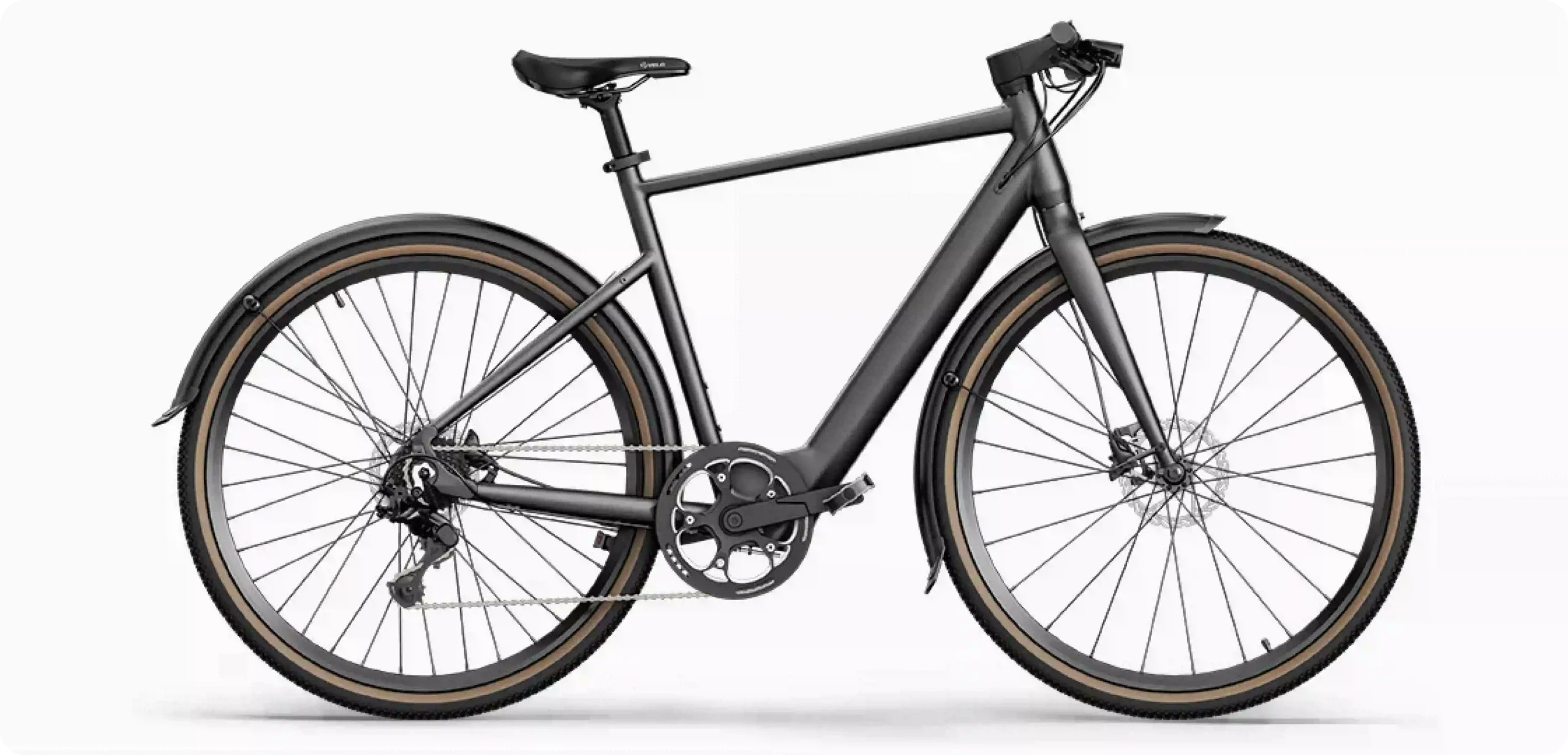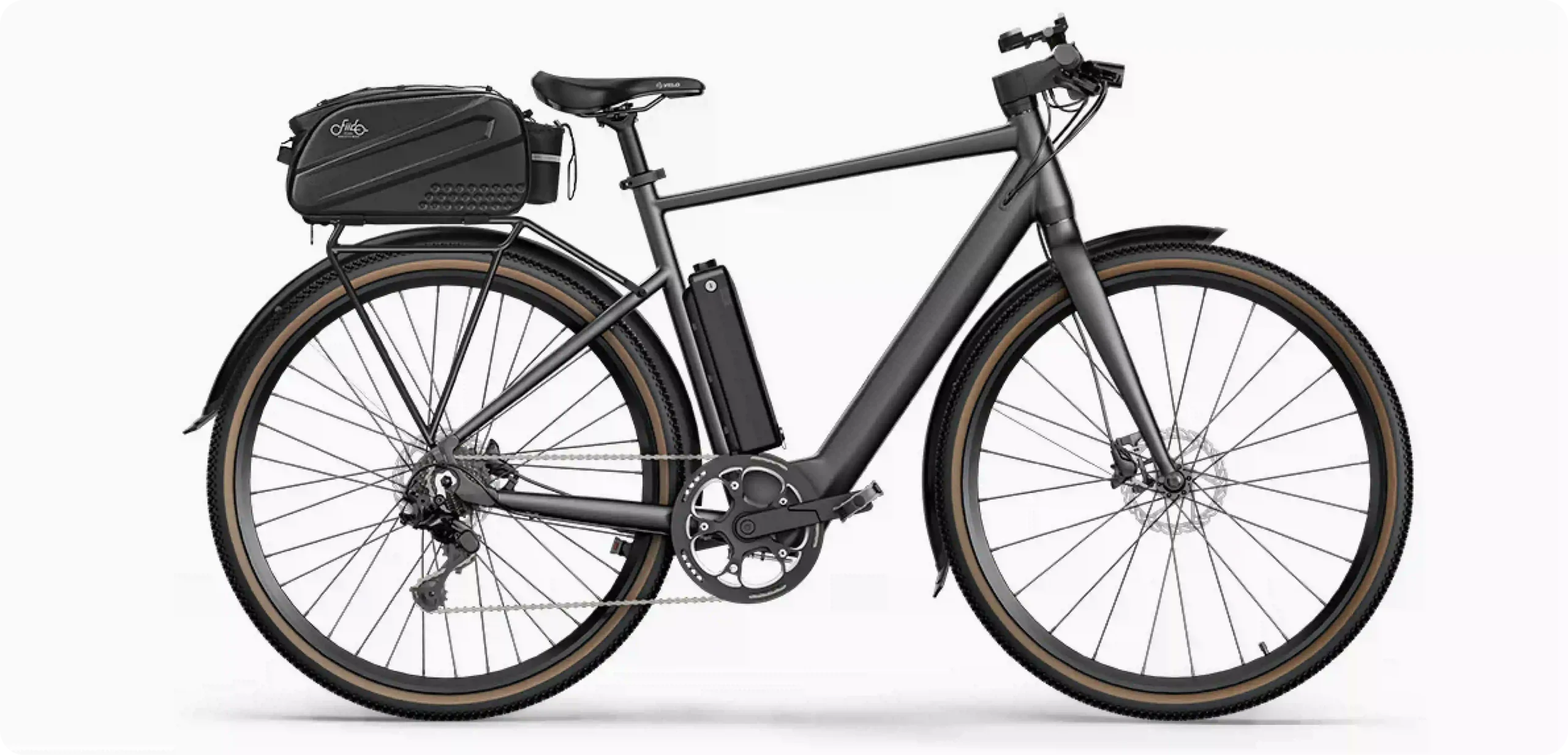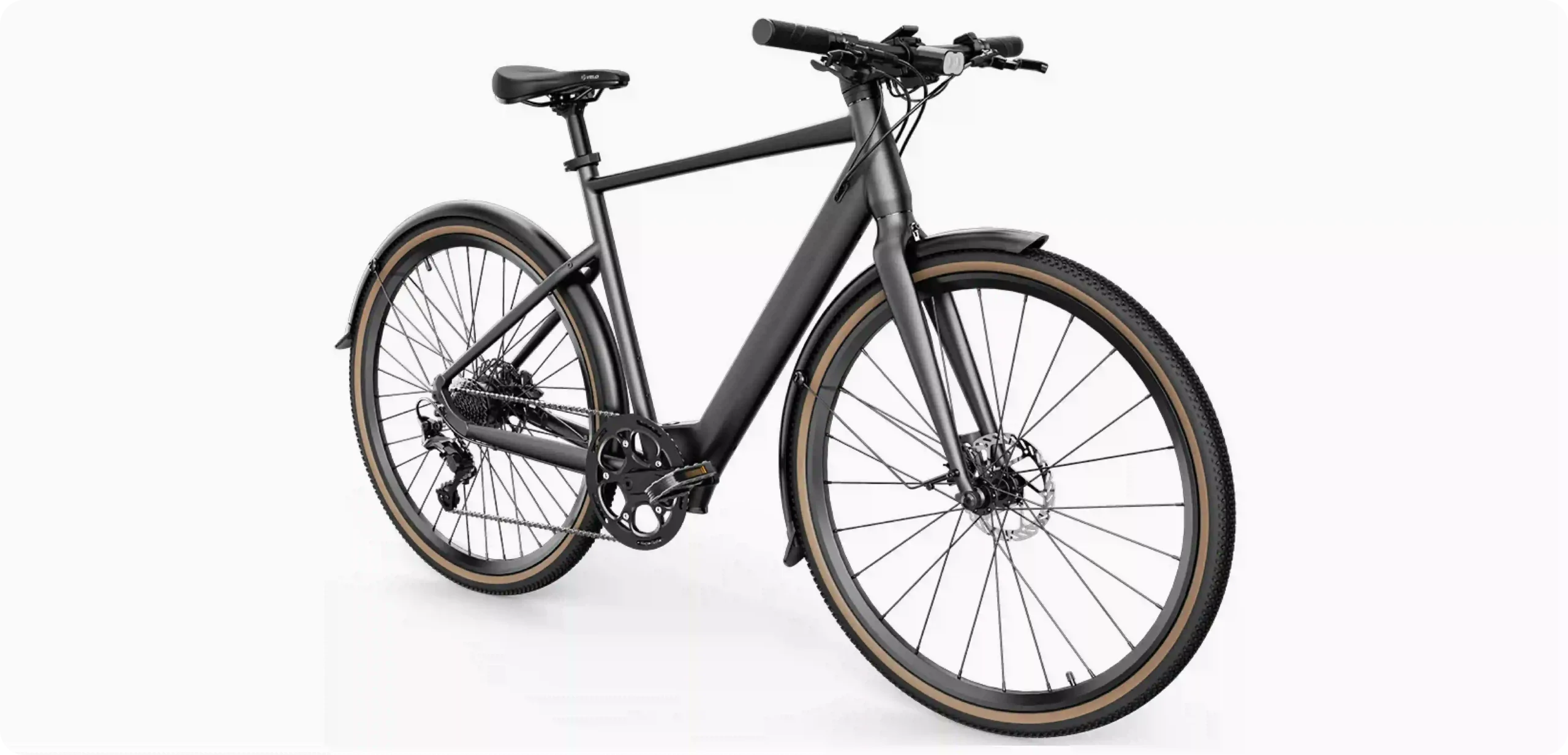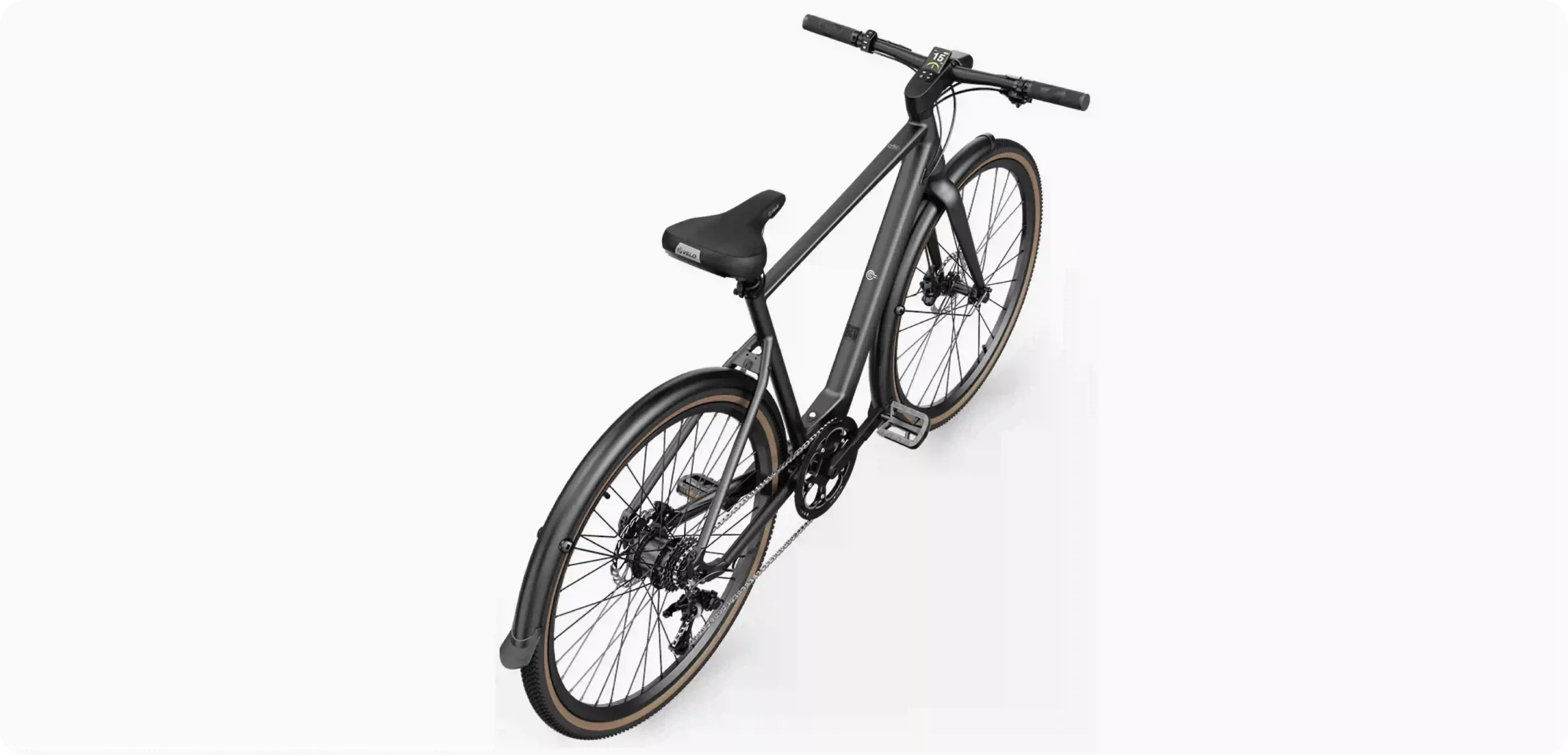Fiido C21




Specifications
Brand
Fiido
Model
C21
Battery
Lithium-ion
Battery Capacity
208.8Wh
Range
Up to 60mi
Charge time
3-4 hours
App
Yes✅
Display
Yes✅
Motor
Hub Motor
Motor Position
Rear Wheel
Motor Power
250W
Top Speed
15mph
Brake System
Hydraulic Disc
Weight
17.5 kg
Wheel Base
28"
Wheel Type
-------
Mudguard
Yes✅
Chain Guard
Yes✅
Drivetrain
L-TWOO RD-5009-M
Light
Yes✅
Warranty
2 years
Pros & Cons
✅17.5 Kg Weight
✅Up to 60mi Range With Paddle Assist
✅Internal Battery Cable
✅Hydraulic Disk Break
✅Affordable Price
❌250W Motor
❌Battery is not Removeable
Description
a bicycle with Aluminum alloy frame, a range of 60 mile on single charge and a top speed of 15 mph, make it the best combination around $999. If you daily commute to your workplace or college, this bicycle may be good choice for you. This e-bicycles light weight frame make it easy to carry and enjoy a carefree ride.
Full Details:
Fiido C21 Review
Electric bikes have surged in popularity for good reason—whether you’re aiming to cut down on gas expenses, squeeze in some light exercise, or avoid the hassle of public transportation, a well-made e-bike can become your go-to solution. And the Fiido C21 seems to know exactly what the modern city commuter needs. It’s compact, tech-savvy, and surprisingly capable for its size—making it a solid choice for anyone tired of crowded buses or endless traffic jams.
In this first part of our in-depth look at the Fiido C21, we’ll dive into what makes this e-bike tick, who it’s best for, and what kind of experience you can expect once you’re in the saddle. Whether you’re a daily rider headed to work or school, or someone looking for a weekend cruise around the neighborhood, the C21 is built to support both practicality and pleasure—without making your wallet cry.
Who Is the Fiido C21 Built For? Is it for You?
If your daily routine includes weaving through traffic to get to class, zipping across town to work, or grabbing coffee and groceries on the go, the C21 might feel like it was designed just for you. It’s tailored for urban commuters who prioritize efficiency but don’t want to compromise on ride comfort or tech integrations. This isn’t some bulky off-road beast—it’s a lightweight, stylish city companion built to keep up with real-life demands.
One of the first things I noticed when riding it was how effortlessly it glided through streets and bike lanes. It felt more like a traditional bicycle than I expected, but with the kind of boost that makes hills and headwinds feel like minor obstacles. That balance—between manual control and motor-assisted ease—is part of what makes the C21 so appealing. It doesn’t try to take over the ride; it works with you.
For students carrying books or laptop bags, office workers dodging traffic, or anyone trying to keep a low environmental footprint while staying active, this bike nails the basics and adds a few clever upgrades that elevate the experience.
Its A Real Commuter's Companion
One of the most refreshing things about the C21 is its sense of purpose. It doesn’t try to be everything for everyone. Instead, it focuses on what matters for daily riders: comfort, reliability, and ease of use.
For starters, the ride itself feels incredibly smooth. Part of that comes from its frame design, which offers stability without bulk. I never felt like I was wrestling with it, even when navigating tight bike racks or narrow sidewalks. The lightweight build makes it easy to lift up a few stairs or onto a train if you need to mix transport modes.
Another factor that stands out is the motor assistance. This bike uses what’s known as a hub motor, which simply means the motor is built into the wheel—usually the rear one, like in this case. It’s a more compact and low-maintenance setup compared to mid-drive motors (those located in the center of the frame), and it delivers a nice push when you start pedaling. For urban riding, where you’re often stopping and starting at intersections, the quick response is a game-changer.
What I appreciated most is that the assistance feels intuitive. The motor doesn’t jolt you forward awkwardly—it gently kicks in as you pedal, giving you just the right amount of boost without overwhelming the ride. This makes it perfect for people who might be new to e-bikes or want something that still feels like cycling, just easier.
Its Subtle Design, Smart Features:
Another thing the C21 gets right is the design. It’s minimalist in the best way. No clunky attachments, no strange wires hanging out—it looks clean and modern. The internal cabling keeps the bike sleek and avoids the tangle of wires you often see on cheaper models. That might sound like a small detail, but it makes a big difference when you’re parking or carrying the bike, and it helps reduce wear over time.
There’s also a built-in display that lets you monitor your speed, battery level, and assist level. It’s simple, but well-placed and easy to read at a glance. If you’re the type of rider who likes having a bit of data without being overloaded by it, you’ll appreciate the setup. Plus, there’s app connectivity for those who want more control or like to log their rides. You can sync up to your phone and get deeper insight into battery usage, trip stats, and ride customization.
Speaking of battery, the integration is seamless. It’s housed within the frame, so the bike doesn’t scream “e-bike” to passersby. That might be a big plus if you prefer a more low-profile aesthetic or want to avoid drawing unnecessary attention when locking it up in public.
Lets Talk about Safety and Ride Control
Riding around a city means you need more than just power—you need control, and that’s where the braking system comes in. The C21 features hydraulic disc brakes, which are one of the most reliable braking systems available on bicycles today. Unlike traditional rim brakes that rely on squeezing the wheel, hydraulic brakes apply force through fluid pressure, allowing for stronger, more consistent stopping even in wet or dusty conditions.
I took it for a spin in mixed weather and noticed how responsive the braking felt. There was never that panicky moment of “am I going to stop in time?”—which, if you’ve ever ridden with worn-out brakes, you know is not a good feeling. The C21 inspires confidence, and that’s huge for everyday riders.
The overall handling is nimble but stable. Whether I was navigating a crowded bike lane or taking a sharp corner near the park, it felt predictable in the best way. You don’t need to be a seasoned cyclist to feel comfortable on this bike.
Has a Lightweight But Durable Frame
At first glance, I wasn’t sure such a lightweight e-bike would hold up well over time—but I was pleasantly surprised. The frame is made from a sturdy aluminum alloy that offers both strength and portability. I’ve had heavier e-bikes in the past, and lugging them up stairs or trying to hang them on a wall mount was an absolute chore. Not with the C21.
This lighter frame makes it ideal for apartment dwellers or students living on campus. It’s easy to carry inside at night or bring up a flight of stairs, and that convenience can’t be overstated if you ride every day.
Of course, being lighter doesn’t mean it feels cheap. Quite the opposite—the build quality comes through in every detail. From the tight welding on the frame to the well-fitted components, the bike gives the impression of a thoughtfully engineered product. You’re not getting a flashy toy; you’re getting a reliable daily tool that happens to be fun to ride.
Smart Riding for the Real World Use
To really understand how an e-bike like the C21 fits into daily life, I put it through a range of real-world scenarios: morning commutes, afternoon errands, evening rides, and even a couple of hill tests. What stood out wasn’t just how easily it handled these tasks—it was how consistently it performed.
One of the biggest questions riders often have is about range—will it actually get you through your daily routine without needing a charge? With a full battery and moderate use of pedal assist, the C21 comfortably covers long distances. The range you get depends on your riding style, terrain, and assist level, but for me, riding mostly on flat terrain with short bursts of assistance, I could confidently go several days without needing to plug in.
That’s one of the key differences you notice when switching from a traditional bike to something like the C21. You’re no longer limited by physical fatigue, weather, or headwinds. Even if you start your ride fresh and energetic, you’ll appreciate the motor support after a long day or when you hit a steep incline.
The Hub Motor Experience: Effortless, Predictable, and Practical
A central component of the C21’s character is its rear hub motor. For those unfamiliar, this type of motor is integrated into the back wheel, and it provides pedal assistance directly to the wheel, rather than through the drivetrain like a mid-drive system.
What this means in practice is a quiet, seamless experience. There’s no jerky feeling, and the transition between pedaling with or without assistance is almost unnoticeable. It’s especially useful when you’re taking off from a complete stop—like at a traffic light or when starting uphill—where it gives you just enough torque to keep things moving smoothly without any sudden surges.
This setup is perfect for beginners or anyone who wants a “plug and play” experience with minimal maintenance. You don’t have to think much about the system—it just works.
How You can Maximize Range and Ride Time
Getting the full benefit of your e-bike isn’t just about charging and riding—it’s also about using it wisely. Here are some things I’ve learned to stretch out the range on the C21 and keep the ride as efficient as possible:
1. Use Assist Levels Strategically:
Start your ride with low to moderate pedal assist, especially on flat roads. Save the higher assist levels for hills or when you’re tired. This can make a big difference in how far your battery lasts.
2. Maintain a Steady Pace:
Stop-and-go traffic eats into your battery more quickly than a steady, controlled pace. If you can, try to keep your cadence consistent and avoid aggressive acceleration.
3. Mind the Tire Pressure:
Keeping your tires properly inflated reduces rolling resistance and improves battery efficiency. Low pressure not only shortens your range but makes the bike feel sluggish.
4. Charge Smart:
Try not to completely drain the battery before charging. Topping up when you hit around 30% tends to be better for long-term battery health.
These habits aren’t just about longevity—they actually improve your riding experience. You get smoother performance, more predictable range, and fewer worries about running out of juice mid-ride.
Smart Features That Actually Help You
With so many “smart” features being thrown around these days, it’s refreshing to see the C21 keep things simple but functional. There’s an onboard display that gives you real-time feedback—speed, battery level, and assist mode—which is enough to stay informed without being distracted.
But where the C21 really aligns with current tech trends is its app integration. This is more than a gimmick; it opens up a whole new layer of control and monitoring. Here’s how to make the most of it:
How to Use the App Features in 4 Simple Steps:
Step 1: Download the Fiido App
Available on both iOS and Android. Pair your bike via Bluetooth—just make sure the bike is powered on during the process.
Step 2: Connect and Customize
Once connected, you can customize riding preferences, set up security features, and even track your routes. It’s a user-friendly interface, and setup takes less than 5 minutes.
Step 3: Monitor Battery and Trips
The app gives you battery diagnostics and estimates for your remaining ride range, which are more accurate than the basic display. It also keeps a log of your rides, which is helpful for commuters or fitness tracking.
Step 4: Apply Updates and Security Features
Firmware updates come through the app, ensuring your bike stays current. There are also some anti-theft features that use your phone as a digital key, which adds peace of mind when locking up in public.
It’s subtle upgrades like this that make the C21 feel like a 2025-ready commuter bike. You’re not just riding—you’re part of a connected ecosystem.
Performance on Hills, Traffic, and Varying Terrain
No e-bike review is complete without answering the golden question: How does it handle hills?
The C21 performs better than I expected, especially considering its modest power rating. On moderate inclines, it maintains a steady, comfortable pace with pedal assist. You’ll still need to contribute a bit of effort, but it never feels like a struggle. On steeper hills, you’ll notice the motor working harder—but it doesn’t overheat or falter.
What helps here is the smooth coordination between the drivetrain and motor support. Gear shifts are crisp and responsive, and there’s enough range in the drivetrain to find a comfortable cadence for most city gradients. You’ll feel empowered rather than exhausted after tackling a hill.
In traffic, the acceleration curve is another asset. The C21 doesn’t lurch forward when assist kicks in—it rolls forward gently, which helps when navigating close quarters or making turns in busy bike lanes.
For uneven terrain like park paths or light gravel trails, the ride remains stable. This isn’t a mountain bike, and it’s not pretending to be—but for light off-pavement rides, it holds its own.
Now its time for Common Concerns and Honest Takeaways
Now, as much as I enjoy the C21, it’s only fair to touch on a few limitations that potential buyers should be aware of.
First off, the battery is built-in. That means you can’t remove it for charging. For some, this isn’t a big deal—especially if you store your bike near an outlet. But if you live in an upper-floor apartment and were hoping to just bring the battery in while leaving the bike downstairs, that’s something to consider.
Another potential drawback is the motor power. While it’s enough for typical urban use, heavier riders or those facing daily hills might feel it’s underpowered compared to some mid-drive options. But again, this depends on your expectations. For city commuting, I never felt limited by the power—though I wouldn’t use it to pull a heavy trailer up a slope.
And finally, while the weight is light for an e-bike, it’s still heavier than a standard bicycle. You notice it when lifting it onto a rack or carrying it up stairs, though the design helps distribute that weight well.
Aligning With Todays Trends
Looking at where e-bike technology is heading, the C21 seems to be right in line with emerging trends:
Connected features like app control and digital displays are becoming expected, not extra—and the C21 delivers them cleanly.
Sleek integration—cables tucked away, internal batteries—offers not just aesthetics, but durability and reduced wear.
Low-maintenance components, like the hub motor and hydraulic disc brakes, are part of a larger push toward stress-free ownership.
And perhaps most importantly: affordability without stripping away core features. That’s what makes the C21 a strong contender in a market that often overprices smart urban bikes.
Frequently Asked Questions (FAQs)
1. Can the battery be charged separately from the bike?
No, the battery is integrated into the frame and cannot be removed for standalone charging. While this helps keep the design sleek and the components secure, it also means you’ll need to bring the entire bike near an outlet. If you’re living in a walk-up apartment or lack access to indoor bike storage, this could be a small challenge to work around.
2. Is the C21 suitable for hilly areas or heavy riders?
The bike performs well on mild to moderate inclines, especially when pedal assist is used wisely. However, for riders in very hilly regions or those expecting high-powered uphill torque, the modest motor output might feel underwhelming. For typical city slopes and overpasses, though, it holds up respectably—especially with good momentum.
3. How comfortable is the ride over long distances?
Thanks to its lightweight frame and well-balanced geometry, the C21 provides a comfortable riding posture for urban environments. While it’s not built for off-road shock absorption, it handles city pavement, bike paths, and occasional gravel routes without issue. The inclusion of full fenders and practical add-ons helps minimize fatigue during longer rides.
4. What kind of maintenance is required?
One of the perks of this e-bike is that it doesn’t demand much maintenance. The rear hub motor is sealed and low-maintenance by design. Occasional chain lubrication, tire pressure checks, and standard brake inspections are generally enough to keep it running smoothly. Hydraulic disc brakes also reduce the frequency of adjustments compared to mechanical ones.
5. How does the app actually help day-to-day?
The app integration is one of the standout features. It allows you to check battery levels, track rides, and even update firmware directly from your phone. This connectivity gives a modern edge to your cycling experience and can be especially helpful for daily commuters looking to log trips or monitor battery health.
6. Is it suitable for beginners or first-time e-bike users?
Absolutely. The C21’s straightforward design and smooth motor engagement make it an excellent choice for those new to electric biking. There’s no learning curve—just hop on, choose your assist level, and ride. The display and app are intuitive, making the overall experience feel approachable.
7. What about customization or accessory upgrades?
While the bike comes with practical features like built-in lights and mudguards, it leaves some room for personalization. You could add a rear rack, pannier bags, or even a phone mount without compromising the bike’s balance or weight distribution. Since it follows standard bicycle sizing in many areas, most basic accessories are compatible.
Honest Reflections and Small Drawbacks
No product is perfect, and the Fiido C21 is no exception. While it shines in practicality and affordability, there are a few limitations that potential buyers should weigh against their personal needs.
The non-removable battery is probably the most notable. For people with easy garage or hallway storage, this won’t be a problem. But if you rely on secure public bike racks or lack convenient indoor charging access, it could add some friction to your daily routine.
Motor output is another area where expectations should be realistic. This is a city bike designed for flat to moderately hilly terrain. It’s not meant to rival mid-drive powerhouses or fat tire trail bikes. However, its performance is adequate—and even enjoyable—within the environment it was made for.
As for weight, while the frame is considered light by e-bike standards, it’s still a bit heavier than a non-electric bicycle. If you need to carry the bike up several flights of stairs regularly, it might not be your first pick. That said, the compact and balanced design makes it far easier to lift and maneuver than many bulkier e-bikes in the same category.
Looking Ahead: Where It Aligns With the Future???
One of the most encouraging aspects of the C21 is how it mirrors several major trends in the e-bike world—without inflating the price. Integrated technology, user-friendly controls, and minimalist design are no longer luxury features. The Fiido C21 proves that these elements are becoming the norm.
As the e-bike market continues to evolve through 2025, we’re seeing a clear shift toward connected commuting—bikes that talk to your phone, give you ride insights, and stay up-to-date with software upgrades. The C21 steps into that space confidently.
There’s also a growing push for sustainable urban transport, especially among students, office workers, and city dwellers looking for cleaner, quieter ways to travel. With its efficiency, comfort, and low operational cost, the C21 fits perfectly into that eco-conscious mindset.
If future models were to add a removable battery option, maybe an optional throttle mode, and a rack-ready frame, they could make an already solid commuter even more versatile. But even as it stands now, the C21 is ahead of many in its class.
Final Verdict
If you’re a student, daily commuter, or casual urban rider who values reliability, simplicity, and a touch of modern tech—this bike is likely a great match. It’s light enough to handle with ease, yet sturdy enough to stand up to real-world conditions. It’s not trying to be flashy or overpowered; instead, it delivers exactly what most people want in a city e-bike: consistency, comfort, and control.
It’s also a smart choice for first-time e-bike buyers who want an affordable introduction without sacrificing quality or convenience. The learning curve is gentle, the app support adds modern value, and the integrated features mean you won’t immediately feel the need for upgrades.
Those looking for high-performance torque for mountain riding or heavy-duty cargo hauling might want to look elsewhere—but for most urban needs, the Fiido C21 holds its own with quiet confidence.
My Final Recommendation
After riding and researching the Fiido C21 extensively, my recommendation is clear: if you want a no-fuss, well-balanced electric bike that prioritizes ease of use, affordability, and smart features, the C21 is absolutely worth considering. It’s the kind of bike that doesn’t try too hard—but still does everything you need it to do.
Whether you’re commuting to work, running errands, or just looking to enjoy a more relaxed ride across town, the C21 offers a satisfying, connected, and eco-friendly way to get there.
